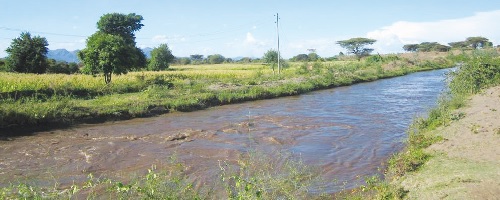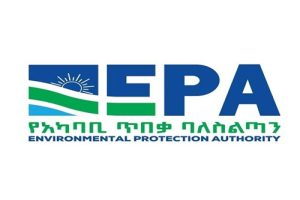
BY EPHREM ANDARGACHEW
Ethiopia’s basins have capacity to develop agriculture in all seasons. However they are not yet adequately exploited and are likely to cause damage when they attain their full regime. Therefore, it is important to build the necessary facility to utilize their potential of development for all seasons and prevent the possible flood disaster.
Awash River and its basin is the most consumed and advantageously usable river basin in Ethiopia. It covers a total of 114,123 km2 area. Hence, the River Basin is the most significant in the country which covers a total land area of 110,000 km2 and serves as home to 10.5 million inhabitants.
The river travels a distance of 1,280 km and contains about 21 main tributaries such as Akaki, Mojo, Keleta, Kesem, Kebena, Borkena, Logia, etc. It comprises five regional states and two city administrations that include Addis Ababa and Dire Dawa.
Kebede Nanesa (2021) academic article entitled “Awash River’s the Ongoing Irrigation Practices, Future Projects and its Impacts on the Environment of Awash River Basin” stated that most of the irrigation-developed tasks to date in Ethiopia are situated in the Awash River Basin. Awash Basin is also the most developed basin in Ethiopia due to the availability of land suitable for agriculture, water resources that can be easily tapped, and its strategic location. The estimated irrigation potential is about 206,000 ha out of which more than 160,000 ha or 77.7 percent (current survey excluding hectares less than 2.5 ha) is already developed by surface irrigation systems and it also serves for drinking.
Despite its benefits to the county, the river has been creating various flooding problems for the nation, in general, the surrounding inhabitants in particular. Ethiopia is vulnerable to climate change and natural disasters such as drought, epidemics, floods, conflict, pests, wildfire, and landslides. These different hazards occur with varying frequency and severity. Some result in nationwide disasters, while the impacts of others are more localized.
The flood in the Awash River basin has been occurring due to the excess rainfall that occurred in the highland of the basin, and finally generates a high flood on the downstream part of the basin. The basin originates from the highlands at above 3,000 meters above sea level receiving 2,000 mm of rainfall. The land use of the basin is characterized by extensive land use for agriculture, combined with urbanization and industrialization, which is aggravating the generation of runoff.
The basin is currently inhabited by 18 million people (growing at 2.9 percent) and supports 34 million livestock population putting immense pressure on the natural resource base. Nonetheless, these factors contribute to severe land degradation, erosion, flooding, and sedimentation. For example, the flood episode at Dire Dawa in 2006 that caused loss of lives and properties, and the frequent flood hazards at Amibara, Gewane, Logiya, and Asaita are some flood events in the basin.
As a result, the National Disaster Risk Management Commission, year to year, has warned about a potential flash flood in some parts of the country when the rain comes. Because some parts of the country are vulnerable to flash floods, especially, areas close to Awash, Baro-Akobo, and Nile River basins, and tributaries are also exposed to flood risks.
The commission has been working with concerned bodies and regional governments to manage the risk and to put some priorities that should be done to prevent harm. According to the Ministry of Water and Energy Minister Dr. Habtamu Etefa, there have been various agreements that help the regions to minimize the vulnerability of flooding and encourage irrigation development by using the river sustainably.
Hence, follow-up and supervision around rivers and tributaries, creating awareness among societies, as well as mending and strengthening dams built to protect flood, maintaining flood canals, and building flood protection barriers should be conducted.
Noting the possibility for disease outbreak during such time, urged the need for the concerned bodies to take precautionary measures to protect vulnerable communities from water-borne diseases, he added.
The water resource management of the Awash River needs to go beyond normal activities including the provision of technical, professional, expert, and other supports. This will help to be more effective for the prevention of flood risks.
Deputy Prime Minister and Minister of Foreign Affairs, Demeke Mekonnen noted that stakeholders should focus on the development of river basins to sustainably solve flood-caused damages. Since natural disasters due to climate change are inevitable “our key focus should be on how to successfully reduce the damage”.
In this regard, focusing on watersheds and basin development is critical to prevent floods sustainably. Because flood crisis which comes through heavy rains have caused damages on people living around Awash, Omo, and Abbay river basins, he underlined.
Taking the damage of the flood and its impact on the surrounding communities into consideration, the Ministry of Water and Energy has started various tasks to prevent the flood risks of the Awash River.
Accordingly, the Awash basin flood crisis prevention consultative meeting, discussions with zonal and woreda leaders, and representatives of institutions are worth mentioning among the tasks that have been held recently. “The discussion, which was held in Awash town with various stakeholders, has mainly focused to prevent further floods risks caused by the Awash River in Afar State,” Dr. Habtamu explains.
Thus, preventive measures, before the Ethiopian rainy season comes, are essential to reducing, if possible, to stop the flood risks. Because the Afar Regional state has been affected by the Awash River.
As stated by various reports and government officials, hundreds of thousands are affected and displaced every year in the region due to the floods following the overflow of Awash River, Qoqa and Tendaho dams. The flooding in Afar has been destroying schools, rural roads, bridges, and so on. It also kills a significant number of domestic animals.
Hence, various government and private institutions have been providing humanitarian support to the victims in expressing solidarity to the people of Afar Regional State. Therefore, it is important paying special attention to upper river basins development and protection since the problem cannot be solved permanently by responding, in the same way, every year.
Taking critical notes from local leaders and residents about the problem caused by the river’s overflow is essential to save the people from the Awash River flooding risks and to allocate money to do necessary tasks. Furthermore, before the onset of the rainy season, it helps to take precautionary measures.
Flooding is a natural disaster that destroys lives and property. So, pre-flood disaster prevention works, if all stakeholders work together and pay attention, can prevent the flood risk, he briefs.
The Ministry pre-protective initiative to tackle the Awash River flood crisis is a significant step to minimize different hazards occurring with varying frequency and severity. Flood risks in the Awash Basin are the most common forms of natural disaster that mess up human activities, cause loss of human lives and destroy properties. The efforts of the government, since the preventive tasks need resources, therefore, should be supported by other concerned bodies before the rainy season comes.
The Ethiopian Herald January 12/2022




